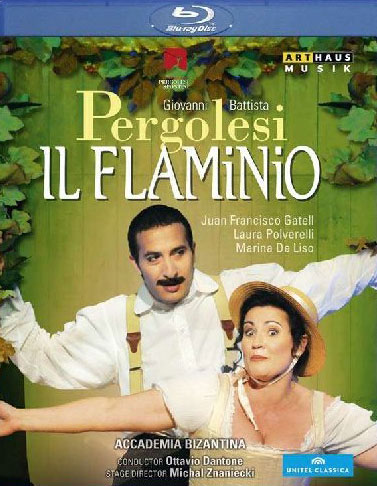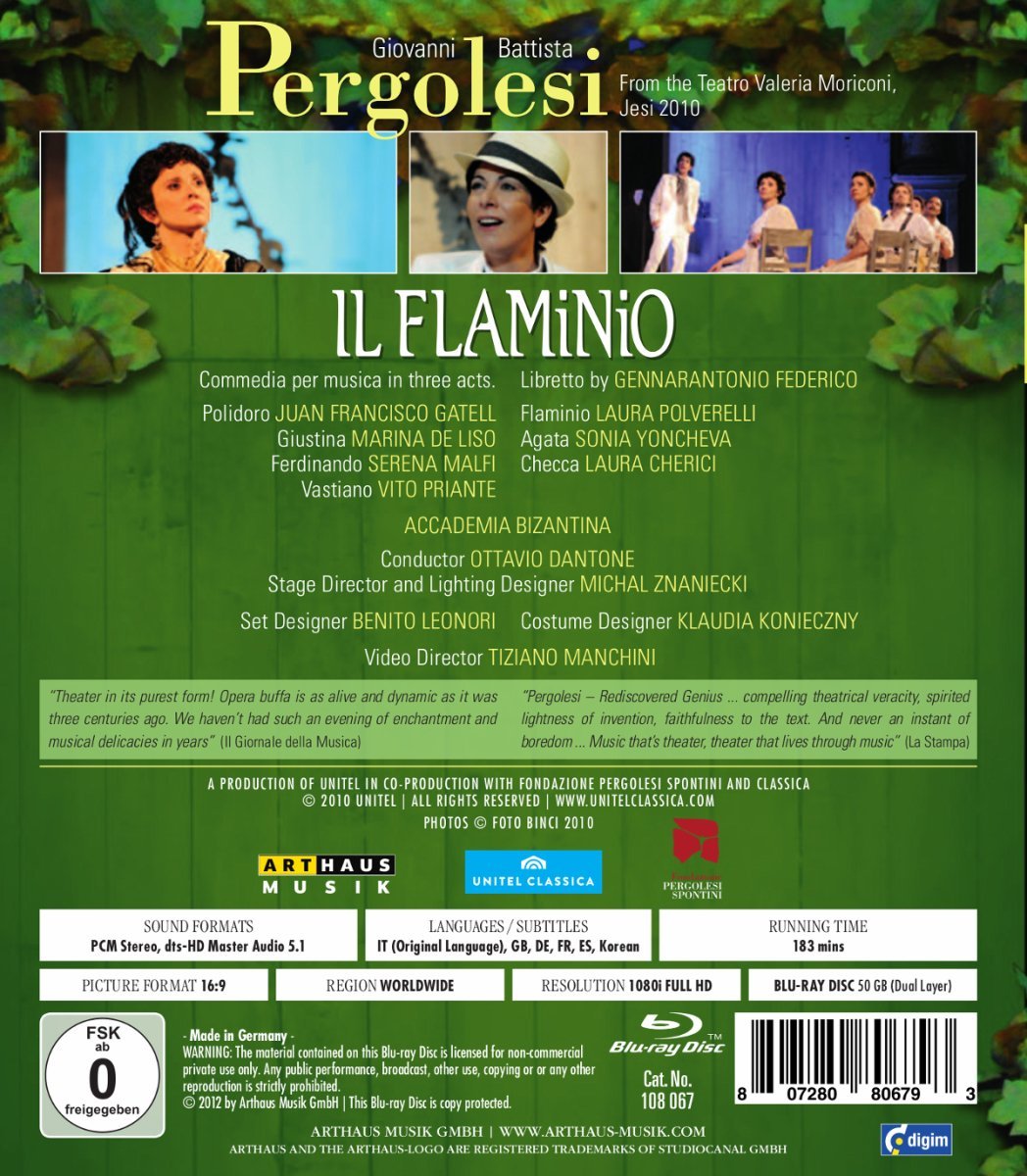06:43
Pergolesi: Il Flaminio / Dantone, Gatell, Polverelli, Yoncheva, Malfi [Blu-ray]
Posted by Listen With Your Eyes
Pergolesi: Il Flaminio / Dantone, Gatell, Polverelli, Yoncheva, Malfi [Blu-ray]
Conductor: Ottavio Dantone | Composer: Giovanni Battista Pergolesi | Directors: Michal Znaniecki, Tiziano Mancini | Performers: Juan Francisco Gatell, Laura Polverelli, Marina De Liso, Sonya Yoncheva, Ottavio Dantone | Orchestra/Ensemble: Accademia Bizantina | Label: Arthaus Musik | Blu-ray | PCM Stereo, dts-HD Master Audio 5.1 (Blu-ray) | 1080i/AVC MPEG-4 | Aspect Ratio: 1080i/AVC MPEG-4 | DTS-HD MA 5.1 (48 kHz / 3411 kbps / 24-bit), LPCM 2.0 (48 kHz / 2304 kbps / 24-bit) | File hosts: Uploaded.net, share-online.biz | 5% recovery + 3 .rev files | Run time: 183 minutes | 42.9 GB Language: Italian | Subtitles: Italian, German, French, Spanish, Japanese, Korean | Live Recording from The Teatro Valeria Moriconi, Jesi 2010
Conductor: Ottavio Dantone | Composer: Giovanni Battista Pergolesi | Directors: Michal Znaniecki, Tiziano Mancini | Performers: Juan Francisco Gatell, Laura Polverelli, Marina De Liso, Sonya Yoncheva, Ottavio Dantone | Orchestra/Ensemble: Accademia Bizantina | Label: Arthaus Musik | Blu-ray | PCM Stereo, dts-HD Master Audio 5.1 (Blu-ray) | 1080i/AVC MPEG-4 | Aspect Ratio: 1080i/AVC MPEG-4 | DTS-HD MA 5.1 (48 kHz / 3411 kbps / 24-bit), LPCM 2.0 (48 kHz / 2304 kbps / 24-bit) | File hosts: Uploaded.net, share-online.biz | 5% recovery + 3 .rev files | Run time: 183 minutes | 42.9 GB Language: Italian | Subtitles: Italian, German, French, Spanish, Japanese, Korean | Live Recording from The Teatro Valeria Moriconi, Jesi 2010

In this sparkling production from the Teatro Valeria Moriconi in 2010 it's an absolute triumph: fresh, genuinely amusing and touching. (...) If you fancy dipping into the bright lights of early eighteenth-century Neapolitan opera, there's nowhere better to start than the uplifting "Il Flaminio".," said Simone Heighes on International Record Review, Juni 2013. The 2010 Jesi production is conscious of the complexity of Flaminio for all its seeming simplicity and cleverly exploits the suggestive milieu of the Teatro Valeria Moriconi, in particular its shape and relatively small scale. Without any attempt at realism, (the main action takes place “in a villa on the outskirts of the city of Naples, complete with hunting lodge, etc.”, but just a handful of props to symbolise the bucolic atmosphere), the production concentrates on establishing a kind of meta-theatrical relationship to this repertoire work which sets out to highlight the interweaving and overlayering of truth and fiction, passion and irony, tragedy and comedy. The orchestra sits behind a broad wooden platform and suspended netting decorated with leaves; every so often scenes about the characters’ private lives open up on various levels (these serve to expand the audience perspective both horizontally and vertically), as if the plot were following the inner development of these living characters. The theatrical narrative unravels – through a brilliant succession of dramatic and light-hearted moments – to its predictable happy ending.
The result takes us a step closer towards finally rediscovering such masterpieces of the Neapolitan school of the 18th century: in addition to being highly serious, ingenious and fabulous entertainment in its own right, Il Flaminio is substantive proof of the key role Naples played in developing the genre for European audiences.
Watch a Trailer (sample is a lower resolution than actual DVD or Blu-ray):
REVIEW
FANFARE: Bill White
About a year or so ago I reviewed Giovanni Battista Pergolesi’s Adriano in Siria , an opera seria by the Italian baroque composer and one of his surviving eight works for the stage. (The short intermezzi Livietta e Tracollo was performed during the intermissions of Adriano, so actually two of the eight works were performed.) At that time, the city fathers of Jesi, Pergolesi’s home town and the Fondazione Pergolesi Spontini were involved in a program to stage and record on video all of the eight stage works of the relatively short-lived composer (he died at age 26). Now, here we go again, this time with Il Flaminio , a commedia per musica in three acts from a different venue, the Teatro Valeria Moriconi in Jesi, and on a new label, Arthaus. I don’t know whether this issue from 2010 is part of that ongoing program to do them all, it doesn’t say in the accompanying literature, but I suspect it is.
Comedy is an ever-evolving genre and, as the booklet points out, often tied to the social experiences of people in a certain locale in a certain age. What was found humorous in 1735 in Naples, where Il Flaminio debuted, is probably not what amuses us today, although with television and the Internet our world view is considerably broader than previously. I’m not saying you had to be there, but Naples humor of the time was tied to even earlier pre-baroque traditions, to local rural dialects, to societal conventions and local politics, to experiences from serious opera, commedia del arte, and even the fare at local puppet theaters, to commonly known folk music. Pergolesi and his librettists built cleverly nuanced humor around that set of common understandings for their audience, much of which is lost to us today. As a new audience in the 21st century for Il Flaminio , we are only able to grasp the broad outlines of the comedic situations but most likely miss what were the really funny bits back then. The Naples audiences also apparently chatted with neighbors, played cards, and snacked on local delicacies and the wines of the region between vocal highlights. They knew what they were doing.
Like Adriano in Siria, Il Faminio is constructed around a mismatched set of people in love, but here played as farce. The setting is a patrician villa in a rural area on the outskirts of Naples. Residents seem to be the owner, the widow Giustina, her betrothed, Polidoro, and Polidoro’s sister, Agata, along with the servants Checca, the maid, and Vastiano, Polidoro’s man. Visitors include Giulio, the accountant (and Giustina’s ex-lover, Flaminio, in disguise) and Ferdinando, betrothed to Agata, but currently on the outs with her. There is a general unhappiness with the current romantic match-ups except for the two servants who delight in poking fun at their so-called betters. As with opera seria, everyone is given a turn or two or three to sing arias as well as a couple of duets and ensembles until there are 31 musical numbers in the piece. It all seems to go on interminably, and is not funny enough to sustain much interest through all the singing.
Apparently, the Teatro Valeria Moriconi does not have an orchestra pit, the small baroque orchestra is positioned on the unlit back of the stage behind a kind of wide rope ladder with leaves attached so we will know we are out in the countryside. Very little attempt is made to convey the villa setting, an open area stage center is apparently the courtyard, and small areas near both wings are employed for small scenarios on two levels (the upper ones apparently balconies off rooms inhabited by the two ladies). At one point a small door opens in the false proscenium stage center for a brief puppet show that mimes the current romantic situation on stage. Costumes are completely traditional although perhaps out of period (I’m not sure if suspenders were an 18th-century product, but I doubt it, and I’m pretty certain cigarettes in silver cases were not of the period). The cast is very strong, a degree better than the youngsters who sang in Adriana. All of these singers, while still young, seem to be more seasoned professionally, not only able to sing well but to take the farce about as far as it can go. The ladies are led by Italian mezzo-soprano Laura Polverelli, in the trousers role of Flaminio (in disguise). Polverelli has sung widely throughout Europe and does not disappoint here. Also of particular note are the Giustina of soprano Marina De Liso and the Polidoro of Juan Francisco Gatell. De Liso provides perhaps the most lovely singing of the show while Gatell, along with the two servants, shoulders much of the comedic load. As with Adriano, the orchestral support is provided by the excellent Academia Bizantina, under the leadership of baroque specialist Ottavio Dantone.
To sum up, Il Flaminio is a quite charming work reasonably staged, with quite enjoyable and well-crafted Baroque era music by Pergolesi. The opera is presented well here by a team of fine singers and comedic actors. If you have on hand plenty of local delicacies to snack on, and plenty of the wine from your region, go for it, just fast-forward if you get a bit bored.
Works on This Recording:
Il Flaminio by Giovanni Battista Pergolesi Performer: Laura Cherici (Soprano), Laura Polverelli (Mezzo Soprano), Marina De Liso (Mezzo Soprano), Juan Francisco Gatell (Tenor), Sonya Yoncheva (Soprano), Serena Malfi (Alto), Vito Priante (Baritone) Conductor: Ottavio Dantone Orchestra/Ensemble: Accademia Bizantina Period: Baroque Written: by 1735; Italy
 No Password
No Password


0 comments:
Post a Comment